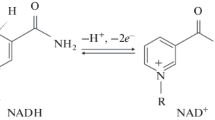Summary
Phenylhydroxylamine added to human red cells under aerobic conditions and in the presence of glucose was partly reduced to aniline. About half the hydroxylamine was recovered as amine after a 2-hr incubation. The aniline, after acetylation, was identified as acetanilide by melting point, Rf-value in TLC as well as UV, IR, and NMR spectroscopy.
The fate of the remaining phenylhydroxylamine was followed by use of 14C-labeled phenylhydroxylamine. About 30% of the total radioactivity was bound to hemoglobin or other proteins and about 20% was found in highly polar low-molecular substances which were insoluble in organic solvents.
The elucidation of the sites at which phenylhydroxylamine was bound to hemoglobin was complicated by the lability of the bonds. When purified human hemoglobin had reacted with radioactive phenylhydroxylamine, large proportions of the radioactivity bound to hemoglobin were removed by treatment with acid or with PMB for separation of α- and β-chains. The radioactive compound liberated from hemoglobin by acid was found to be aniline.
After reaction with phenylhydroxylamine the number of SH groups titrable with PMB was found to be diminished. Pretreatment of hemoglobin with N-ethylmaleimide or PMB decreased the amount of phenylhydroxylamine bound to hemoglobin but did not fully prevent the reaction.
Tryptic digestion of hemoglobin after reaction with radioactive phenylhydroxylamine yielded tryptic peptides with lower specific activity than that of hemoglobin. Chymotryptic digestion of the tryptic core yielded a core with specific activity much higher than that of hemoglobin. Fingerprinting of the tryptic or chymotryptic hydrolyzates showed the presence of peptides with high and other ones with low or no radioactivity and of radioactive compounds which did not react with ninhydrin.
In the covalent binding of phenylhydroxylamine to globin the SH group β93 plays an important role, but other yet unknown sites are also reactive.
Similar content being viewed by others
References
Baglioni, C.: An improved method for the fingerprinting of human hemoglobin. Biochim. biophys. Acta (Amst.) 48, 392–396 (1961)
Baglioni, C.: Analysis of the human adult hemoglobin “core”. Biochim. biophys. Acta (Amst.) 65, 389–393 (1962)
Bamberger, E., Renauld, E.: Über alphylierte und alkylierte Hydroxylamine. Ber. dtsch. chem. Ges. 30, 2278–2289 (1897)
Boyer, P. D.: Spectrophotometric study of the reaction of protein sulfhydryl groups with organic mercurials. J. Amer. chem. Soc. 76, 4331–4337 (1954)
Brodie, B. B., Axelrod, J.: The estimation of acetanilide and its metabolic products, aniline, N-acetyl p-aminophenol and p-aminophenol (free and total conjugated) in biological fluids and tissues. J. Pharmacol. exp. Ther. 94, 22–28 (1948)
Bucci, E., Fronticelli, C.: A new method for the preparation of alpha and beta subunits of human hemoglobin. J. biol. Chem. 240, PC 551 (1965)
Dannenberg, H., Kiese, M.: Kinetik der Hämiglobinbildung. X. Reduktion von Nitrosobenzol in roten Zellen. Naunyn-Schmiedebergs Arch. exp. Path. Pharmak. 211, 410–420 (1950)
Eyer, P.: Unpublished experiments (1974)
Eyer, P., Hertle, H., Kiese, M., Klein, G.: Kinetics of ferrihemoglobin formation by some reducing agents, and the role of hydrogen peroxide. Molec. Pharmacol. 11, 326–334 (1975)
Eyer, P., Kiese, M., Lipowsky, G., Weger, N.: Reactions of 4-dimethylaminophenol with hemoglobin, and autoxidation of 4-dimethylaminophenol. Chemico-Biol. Interact. 8, 41–59 (1974)
Geraci, G., Parkhurst, L. J., Gibson, Q. H.: Preparation and properties of alpha- and beta-chains from human hemoglobin. J. biol. Chem. 244, 4664–4667 (1969)
Goldschmidt, C.: Zur Darstellung von Phenylhydroxylamin. Ber. dtsch. chem. Ges. 29, 2307 (1896)
Haan, J., Kiese, M., Werner, A.: Reduktion von Nitrosobenzol zu Anilin in roten Blutzellen. Naunyn-Schmiedebergs Arch. exp. Path. Pharmak. 235, 365–372 (1959)
Herr, F., Kiese, M.: Bestimmung von Nitrosobenzol im Blute. Naunyn-Schmiedebergs Arch. exp. Path. Pharmak. 235, 351–353 (1959)
Ingram, V. M.: Abnormal human hemoglobin. I. The comparison of normal human and sickle-cell haemoglobins by “finger-printing”. Biochim. biophys. Acta (Amst.) 28, 539–545 (1958)
Kiese, M.: Oxydation von Anilin zu Nitrosobenzol im Hunde. Naunyn-Schmiedebergs Arch. exp. Path. Pharmak. 235, 354–359 (1959)
Kiese, M.: Methemoglobinemia: A comprehensive treatise. Cleveland: CRC Press 1974
Kiese, M., Wiedemann, I.: Elimination of N-hydroxy arylamines from the blood of guinea pigs. Biochem. Pharmacol. 17, 1151–1158 (1968)
Kiese, M., Reinwein, D., Waller, H. D.: Kinetik der Hämiglobinbildung. IV. Mitteilung. Die Hämiglobinbildung durch Phenylhydroxylamin und Nitrosobenzol in roten Zellen in vitro. Naunyn-Schmiedebergs Arch. exp. Path. Pharmak. 210, 393–398 (1950)
Liebold, B., Braunitzer, G.: Über Hämoglobine. II. Die tryptische Spaltung des Humanglobins A. Hoppe-Seylers Z. physiol. Chem. 315, 271–277 (1959)
Miller, E. C., Miller, J. A.: Mechanism of chemical carcinogenesis: Nature of proximate carcinogens and interactions with macromolecules. Pharmac. Rev. 18, 805–830 (1966)
Miller, J. A.: Carcinogenesis by chemicals: An overview—G. H. A. Clowes memorial lecture. Cancer Res. 30, 559–576 (1970)
Miller, J. A., Miller, E. C.: The metabolic activation of carcinogenic aromatic amines and amides. Progr. exp. Tumor Res. 11, 273–301 (1969)
Tautz, Ch., Kleihauer, E.: Gibt es ein fetales Hämoglobin beim Schwein? II. Analysen des Globins. Res. exp. Med. 159, 44–49 (1972)
Teale, F. W. J.: Cleavage of the haem-protein link by acid methylethylketone. Biochim. biophys. Acta (Amst.) 35, 543 (1959)
Utzinger, G. E.: N-substituierte Arylhydroxylamine und ihre Eigenschaften. Justus Liebigs Ann. Chem. 556, 50–64 (1944)
Author information
Authors and Affiliations
Rights and permissions
About this article
Cite this article
Kiese, M., Taeger, K. The fate of phenylhydroxylamine in human red cells. Naunyn-Schmiedeberg's Arch. Pharmacol. 292, 59–66 (1976). https://doi.org/10.1007/BF00506490
Received:
Accepted:
Issue Date:
DOI: https://doi.org/10.1007/BF00506490




